Renewable energy in Germany
Renewable energy in Germany is mainly based on wind, solar and biomass. Germany had the world's largest photovoltaic installed capacity until 2014, and as of 2020 it has 49 GW. It is also the world's third country by installed wind power capacity, at 59 GW in 2018,[1] and second for offshore wind, with over 4 GW. Germany has been called "the world's first major renewable energy economy".[2][3]
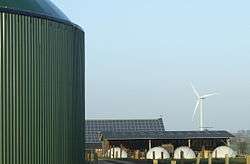 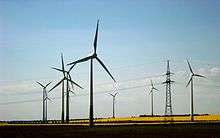 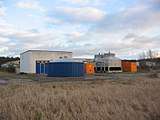 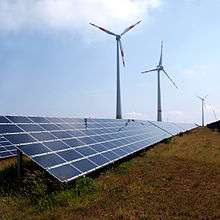 |
| Renewable Energy in Germany (from top left to bottom right): · Biogas fermenter in Hornstet · Wind park in Bernburg · Geothermal power plant in Neustadt-Glewe · German wind and solar in Rhineland-Palatinate |
_jobs.jpg)
The share of renewable electricity rose from just 3.4% of gross electricity consumption in 1990 to exceed 10% by 2005, and reaching 46.3% of consumption in 2019.[4] As with most countries, the transition to renewable energy in the transport and heating and cooling sectors has been considerably slower.
According to official figures, around 370,000 people were employed in the renewable energy sector in 2010, particularly in small and medium-sized companies.[5] This is over twice the number of jobs in 2004 (160,500). About two-thirds of these jobs are attributed to the Renewable Energy Sources Act.[6][7]
Germany's federal government is working to increase renewable energy commercialization,[8] with a particular focus on offshore wind farms.[9] A major challenge is the development of sufficient network capacities for transmitting the power generated in the North Sea to the large industrial consumers in southern parts of the country.[10] Germany's energy transition, the Energiewende, designates a significant change in energy policy from 2011. The term encompasses a reorientation of policy from demand to supply and a shift from centralized to distributed generation (for example, producing heat and power in very small cogeneration units), which should replace overproduction and avoidable energy consumption with energy-saving measures and increased efficiency.
Targets
- Nuclear: 71.09 TWh (13.8%)
- Brown Coal: 102.18 TWh (19.9%)
- Hard Coal: 48.69 TWh (9.5%)
- Natural Gas: 54.05 TWh (10.5%)
- Wind: 127.22 TWh (24.8%)
- Solar: 46.54 TWh (9.1%)
- Biomass: 44.42 TWh (8.7%)
- Hydro: 19.23 TWh (3.7%)
Since the passage of the Directive on Electricity Production from Renewable Energy Sources in 1997, Germany and the other states of the European Union were working towards a target of 12% renewable electricity by 2010. Germany passed this target early in 2007, when the renewable energy share in electricity consumption in Germany reached 14%.[12] In September 2010, the German government announced ambitious energy targets:[13]:5 After the 2013 elections, the new CDU/CSU and SPD coalition government continued the energy transition, with only minor modifications of its targets in the coalition agreement.[14] These targets include, for renewable energy:
| Target | 2015 | 2020 | 2030 | 2040 | 2050 |
|---|---|---|---|---|---|
| Share of gross final energy consumption | 14.9% | 18% | 30% | 45% | 60% |
| Share of gross electricity consumption | 31.6% | ≥35% | ≥50% | ≥65% | ≥80% |
| Share of heat consumption | 13.2% | 14% | N/A | N/A | N/A |
| Share in transport sector | 5.2% | 10% | N/A | N/A | N/A |
The German Government reported, in 2011, renewable energy (mainly wind turbines and biomass plants) generated more than 123 TWh of electricity, providing nearly 20% of the 603 TWh of electricity supplied.[16] By 2012, all renewable energy accounted for 21.9% of electricity, with wind turbines and photovoltaic providing 11.9% of the total.[17]
As of 2017, renewable sources account for 38% of the net electricity production. Compared to the same period of 2016, energy production from renewable energy sources increased from 182 TWh to 210 TWh. It marks the first year where solar and wind are the biggest source of energy. Power production from nuclear power plants decreased by 10%, due to maintenance. Use of hard coal decreased by 16%, while production from lignite stayed on a similar level and increased for gas by 2.6 TWh.[18]:4–6
The renewable installations have come under criticism as well. A balance made in 2017 has shown that whilst emissions in 2016 were 28 percent lower than 1990, the country was likely to fall short of its 2020 target of a 40 percent reduction on 1990 emission levels. The 40 percent reduction target of 2020 will not be met unless "spectacular" additional efforts are made.[19][20] One significant reason why Germany may miss its 2020 target is because the country's electricity exports have been growing strongly in recent years to surpass France as Europes largest electricity exporter. A recent study calculates that Germany exports the equivalent of the annual output from 7GW of lignite generation – producing 59m tonnes of CO2 emissions in the process, a figure which accounts for around half of the shortfall in CO2 emissions it needs to meet its 2020 targets.[21] Replacing the baseload power from fossil fuels has proven more challenging after nuclear power plants have been shut down although the proportion of electricity generated by coal for domestic use has been falling year on year.
In July 2019, figures published by the Fraunhofer Institute for Solar Energy Systems (ISE) report that renewable energy is for the first time providing more electricity than coal and nuclear power combined in Germany. Solar, wind, biomass and hydroelectric power generates nearly half of the country's output.[22][23] Times with negative prices increased as solar and wind power increased. Solar and wind power has low marginal cost, and other production sources with higher fuel costs become less competitive when demand and prices are low. During the COVID-19 pandemic in Germany, solar power in Germany occasionally produced 32 Gigawatt. Solar, together with wind and other renewables, accounted for 78% of German power at one point.[24]
Primary energy consumption
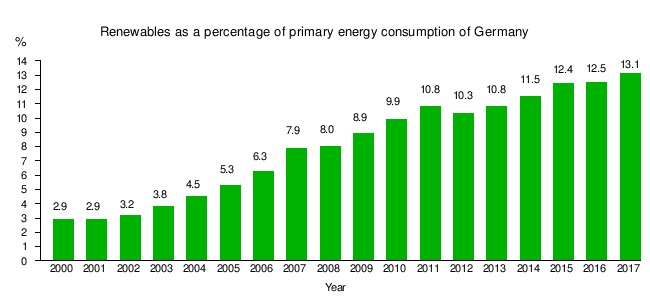 |
As of 2015 Germany's primary energy consumption of 13 218 petajoules or 3 672 terawatt-hours refers to the total energy used by the nation. The final renewable energy consumption, split by the sectors, and with their relative share, are:[25]:4,5,10
- Electricity sector, with a renewable energy consumption of 31.5% (187.364 GWh)
- Heating sector, with a renewable energy consumption of 13.3% (158.662 GWh)
- Transportation sector, with a renewable energy consumption of 5.3% (33.611 GWh)
As of the end of 2015, renewable energy sources, such as biomass, biogas, biofuels, hydro, wind and solar, accounted for 12.4% of the country's primary energy consumption, a more than doubling compared to 2004, when renewables only contributed 4.5%.[25]:5
Although the terms "energy" and "electricity" are often used interchangeably, they should not be confused with one another, as electricity is only one form of energy and does not account for the energy consumed by combustion engines and heat boilers, used in transportation by vehicles and for the heating of buildings.
Sources
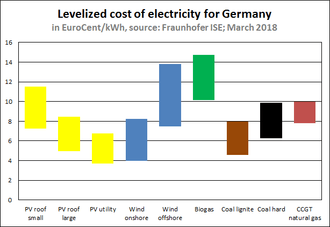
A travel guide to renewable energy destinations in Germany was published in 2016.[27]
Wind power
In 2013, wind power generated a total of 53.4 TWh of electricity and more than 3.2 GW of new capacity was added to the grid.[29] In 2011, the country's installed capacity of wind power reached 29,075 megawatts (MW), about 8% of the overall capacity.[30] According to EWEA, in a normal wind year, installed wind capacity in Germany will meet 10.6% at end 2011 and 9.3% at end 2010 of the German electricity needs.[31][32]
More than 21,607 wind turbines are located in the German federal area and the country has plans to build more.[33][34] As of 2011, Germany's federal government is working on a new plan for increasing renewable energy commercialization,[8] with a particular focus on offshore wind farms.[9] A major challenge is the development of sufficient network capacities for transmitting the power generated in the North Sea to the large industrial consumers in southern Germany.[10] In 2016, Germany decided to replace feed-in tariffs with auctions from 2017.[35]
Biomass
The key provider of biomass supply in Germany is supposed to be agriculture. Moreover, 40% of German wood production is also used as a biomass feedstock.[36] The German Federal Research Centre for Forestry and Forest Products claims that there are also reserves which may assist in enlarging the part of forestry in biomass production. Agriculture is the main source of rapeseed oil, which is used for the production of biodiesel and making substrates for the production of biogas.[37]
Biomass used for the production of biogas and biofuels are some of Germany's most important sources of renewable energy. In 2010, biomass accounted for 30% of renewable electricity generation and for 70% of all renewable energy (mostly wood).[38]
Germany has committed to blending 6.25% biofuels in petroleum by 2014 with the Biofuels Quota Act.[39][40]
Photovoltaic solar power
Solar photovoltaic (PV) technology generates electricity from sunlight, and it can be used in grid-connected and off-grid applications. They were first mass-produced in the year 2000, when German environmentalists and Eurosolar have succeeded in obtaining the government support for the 100,000 roofs program.[42] In July 2012, a cumulative installed total solar PV power of 29.7 GW was in place.[43] Solar PV provided 18 TW·h in 2011, 3% of the total electricity demand. As solar power installations rise quickly, in first half of 2012, about 5.3% of the total electricity demand was covered by solar power.[44] On Saturday 25 May 2012, solar power broke a new record high, feeding 22 GW into the power grid, or as much as 20 nuclear power stations. This jump above the 20 GW level was due to increased capacity and excellent weather conditions countrywide, and made up for half of the nation's electricity demand at midday.[45] Germany was also the biggest expanding market for solar PV 2012, with 7.6 GW of newly connected systems.[46] Some market analysts expect the solar electricity share could reach 25% by 2050.[47] Price of PV systems has decreased more than 50% in 5 years since 2006.[48]
Hydroelectricity
The total installed hydroelectric capacity in Germany at the end of 2006 was 4.7 GW. Hydropower meets 3.5% of the electricity demand. Latest estimates show, in Germany in 2007, about 9,400 people were employed in the hydropower sector which generated a total turnover of €1.23 billion.[49]
Geothermal power
Geothermal power in Germany is expected to grow, mainly because of a law that benefits the production of geothermal electricity and guarantees a feed-in tariff. But after a renewable energy law that introduced a tariff scheme of €0.15 (US$0.23) per kilowatt-hour (kWh) for electricity produced from geothermal sources came into effect that year, a construction boom was sparked and the new power plants are now starting to come online.
Industry
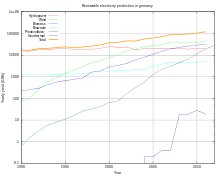
Germany's renewable energy sector is among the most innovative and successful worldwide. Enercon, Nordex, REpower Systems, Siemens, and Fuhrländer are wind-power companies based in Germany. Every third solar panel and every second wind rotor in Germany are German, and German turbines and generators used in hydro energy generation are among the most popular worldwide.
Nearly 800,000 people work in the German environment technology sector; an estimated 214,000 people work with renewables in Germany, up from 157,000 in 2004, an increase of 36%.[50] Estimated German jobs in renewable energy in 2012–2013 were about 370,000.[51]
Siemens chief executive Peter Löscher believes Germany's target of generating 35% of its electricity from renewables by 2020 is achievable – and, most probably, profitable for Europe's largest engineering company. Its "environmental solutions" portfolio, which is firmly focused on renewables, is "already generating more than €27 billion a year, 35 per cent of Siemens’ total revenue, and the plan is to grow this to €40 billion by 2015". Ending its involvement in nuclear industry will boost the credibility of Siemens as a purveyor of "green technology".[52]
Germany's main competitors in solar electricity are Japan, the US, and China. In the wind industry, it is Denmark, Spain, and the US.
Government policy
The renewable energy sector benefited when the Alliance '90/The Greens party joined the federal government between 1998 and 2005. Support for renewable energy continued under all following governments, regardless of composition, including the current CDU/CSU and SPD coalition government starting in 2018. The renewable energy sector was aided especially by the Renewable Energy Sources Act that promotes renewable energy mainly by stipulating feed-in tariffs and recently also market premiums that grid operators must pay for renewable energy fed into the power grid. People who produce renewable energy can sell their 'product' at fixed prices for a period of 20 or 15 years. This has created a surge in the production of renewable energy.[53] In 2012, Siemens estimated the total cost of renewable energy would come to at least €1.4 trillion (US$1.8 trillion) by 2030.[54]
For the 2011–2014 period, the federal government set aside 3.5 billion euros for scientific research in the country.[55] Additionally, in 2001 a law was passed requiring the closing of all nuclear power plants within a period of 32 years. The shutdown time was extended to 2040 by a new government in 2010. After the Fukushima incident, the law was abrogated and the end of nuclear energy was set to 2022.[56] After the 2013 federal elections, the new CDU/CSU and SPD coalition in important areas continued the Energiewende of the previous government, but also agreed on a major revision of the EEG.[57]
The German energy policy is framed within the European Union, and the March 2007 European Council in Brussels approved a mandatory energy plan that requires a 20% reduction of carbon dioxide emissions before the year 2020 and the consumption of renewable energies to be 20% of total EU consumption (compared to 7% in 2006).[58] The accord indirectly acknowledged the role of nuclear energy — which is not commonly regarded as renewable, but emissions-free — in the reduction of the emission of greenhouse gases, allowing each member state to decide whether or not to use nuclear-generated electricity.[59]
Also, a compromise was reached to achieve a minimum quota of 10% biofuels in the total consumption of gasoline and diesel in transport in 2020.
Energy transition
Energiewende ("energy transition") designates a significant change in energy policy: The term encompasses a reorientation of policy from demand to supply and a shift from centralized to distributed generation (for example, producing heat and power in very small cogeneration units), which should replace overproduction and avoidable energy consumption with energy-saving measures and increased efficiency.
The key policy document outlining the Energiewende was published by the German government in September 2010, some six months before the Fukushima nuclear accident.[13] In addition, there will be an associated research and development drive. Legislative support was passed in September 2010. Important aspects include:
| Target | 2015 | 2020 | 2030 | 2040 | 2050 |
|---|---|---|---|---|---|
| Greenhouse gas emissions (base year 1990)* | −27.2% | −40% | −55% | −70% | −80%
to −95% |
| Renewable energy share of gross final energy consumption | 14.9% | 18% | 30% | 45% | 60% |
| Renewable energy share of gross electricity consumption | 31.6% | ≥35% | ≥50% | ≥65% | ≥80% |
| Primary energy consumption (base year 2008) | −7.6% | −20% | up | to | −50% |
| Gross electricity consumption (base year 2008) | −4.0% | −10% | up | to | −25% |
| *Provisional figure for 2015 | |||||
The policy has been embraced by the German federal government and has resulted in a huge expansion of renewables, particularly wind power. Germany's share of renewables has increased from around 5% in 1999 to 22.9% in 2012, reaching close to the OECD average of 18% usage of renewables.[60] Producers have been guaranteed a fixed feed-in tariff for 20 years, guaranteeing a fixed income. Energy co-operatives have been created, and efforts were made to decentralize control and profits. The large energy companies have a disproportionately small share of the renewables market. Nuclear power plants were closed, and the existing nine plants will close earlier than planned, in 2022.
In May 2013, the International Energy Agency commended Germany for its commitment to developing a comprehensive energy transition strategy, ambitious renewable energy goals, and plans to increase efficient energy use and supported this approach. Nevertheless, the scale of Germany's energy policy ambitions, coupled with the large size and energy intensity of its economy, and its central location in Europe's energy system, mean further policy measures must be developed if the country's ambitious energy transition is to maintain a workable balance between sustainability, affordability, and competitiveness.[61]
Subsidies aimed at stimulating the growth of renewables have driven up consumer energy prices by 12.5% in 2013.[62] To date, German consumers have absorbed the costs of the Energiewende, but the IEA says the debate over the social and economic impacts of the new approach has become more prominent as the share of renewable energy has continued to grow alongside rising electricity prices. The transition to a low-carbon energy sector requires public acceptance, and, therefore, retail electricity prices must remain at an affordable level. Presently, German electricity prices are among the highest in Europe, despite relatively low wholesale prices.[61] At the same time, the IEA said the new energy policy is based on long-term investment decisions, and a strong policy consensus in Germany in favour of large-scale renewable energy commercialisation exists.[61]
The Energiewende has been subject to a number of computer studies. Most concentrate on electricity generation and consumption as this sector is undergoing a rapid transition in terms of technologies and institutions.
Ownership
In Germany, almost half of renewable power capacity was citizen-owned as of 2013, and about 20 million Germans lived in so-called 100% renewable energy regions.[63]
Statistics
Increases in installed renewable electric power capacity and generation in recent years is shown in the charts and table below:[25]
Hydro Waste incineration Onshore Wind Offshore Wind Solar PV Biomass
| Year | Installed capacity [MW] |
Electric gross generation in gigawatt-hours [GWh] by renewable sources since 1990 | Share of gross electricity consumption [%] | |||||||
|---|---|---|---|---|---|---|---|---|---|---|
| Hydro | Wind | Biomass[64] | Biogenic waste incineration[65] |
Photovoltaics | Geothermal | Total generation | ||||
| onshore | offshore | |||||||||
| 1990 | 4,718 | 17,426 | 72 | – | 222 | 1,213 | 1 | – | 18,934 | 3.4 |
| 1991 | 4,826 | 14,891 | 102 | – | 260 | 1,211 | 1 | – | 16,465 | 3.1 |
| 1992 | 4,918 | 17,397 | 281 | – | 296 | 1,262 | 4 | – | 19,240 | 3.6 |
| 1993 | 5,190 | 17,878 | 612 | – | 432 | 1,203 | 3 | – | 20,128 | 3.8 |
| 1994 | 5,548 | 19,930 | 927 | – | 569 | 1,306 | 7 | – | 22,739 | 4.3 |
| 1995 | 6,223 | 21,780 | 1,530 | – | 662 | 1,348 | 7 | – | 25,327 | 4.7 |
| 1996 | 6,694 | 21,957 | 2,073 | – | 755 | 1,343 | 12 | – | 26,140 | 4.7 |
| 1997 | 7,255 | 17,357 | 3,025 | – | 876 | 1,397 | 18 | – | 22,673 | 4.1 |
| 1998 | 8,301 | 17,216 | 4,579 | – | 1,638 | 1,618 | 35 | – | 25,086 | 4.5 |
| 1999 | 10,155 | 19,647 | 5,639 | – | 1,845 | 1,740 | 30 | – | 28,091 | 5.2 |
| 2000 | 12,330 | 21,732 | 9,703 | – | 2,887 | 1,844 | 60 | – | 36,226 | 6.3 |
| 2001 | 15,157 | 22,733 | 10,719 | – | 3,355 | 1,859 | 76 | – | 38,742 | 6.6 |
| 2002 | 18,824 | 23,124 | 16,102 | – | 4,099 | 1,949 | 162 | – | 45,436 | 7.7 |
| 2003 | 22,099 | 17,722 | 19,087 | – | 6,603 | 2,238 | 313 | – | 45,963 | 7.6 |
| 2004 | 25,340 | 20,095 | 26,019 | – | 8,218 | 2,253 | 557 | 0.2 | 57,142 | 9.3 |
| 2005 | 29,040 | 19,638 | 27,774 | – | 11,102 | 3,252 | 1,282 | 0.2 | 63,048 | 10.2 |
| 2006 | 32,849 | 20,008 | 31,324 | – | 14,793 | 3,907 | 2,220 | 0.4 | 72,252 | 11.6 |
| 2007 | 36,046 | 21,170 | 40,507 | – | 19,832 | 4,531 | 3,075 | 0.4 | 89,115 | 14.3 |
| 2008 | 39,113 | 20,443 | 41,385 | – | 23,121 | 4,671 | 4,420 | 18 | 94,058 | 15.1 |
| 2009 | 47,958 | 19,031 | 39,382 | 38 | 26,334 | 4,323 | 6,583 | 19 | 95,710 | 16.4 |
| 2010 | 57,313 | 20,953 | 38,371 | 176 | 29,179 | 4,746 | 11,729 | 28 | 105,182 | 17.0 |
| 2011 | 68,171 | 17,671 | 49,280 | 577 | 32,136 | 4,755 | 19,599 | 19 | 124,037 | 20.3 |
| 2012 | 78,864 | 22,091 | 50,948 | 732 | 38,266 | 4,951 | 26,380 | 25 | 143,393 | 23.5 |
| 2013 | 84,703 | 22,998 | 51,815 | 918 | 40,113 | 5,415 | 31,010 | 80 | 152,353 | 25.1 |
| 2014 | 91,275 | 19,587 | 57,026 | 1,471 | 42,232 | 6,069 | 36,056 | 98 | 162,539 | 27.4 |
| 2015 | 98,818 | 18,977 | 72,340 | 8,284 | 44,573 | 5,768 | 38,726 | 133 | 188,801 | 31.5 |
| 2016 | 105,568 | 20,546 | 67,650 | 12,274 | 44,996 | 5,930 | 38,098 | 175 | 189,669 | 31.6 |
| 2017 | 113,911 | 19,800 | 88,667 | 17,947 | 45,486 | 5,907 | 39,895 | 155 | 217,587 | 36.2 |
| 2018 | 118,323 | 16,500 | 92,249 | 19,341 | 45,110 | 6,155 | 46,164 | 172 | 225,691 | 37.8 |
| Source: Federal Ministry for Economic Affairs and Energy (German: Bundesministerium für Energie und Wirtschaft)[25]:6, 7 Version: last published PDF data sheet as per February 2018[25] Note: column "Biomass" contains all generated electricity from biomass, biofuels and biogas, excluding generation from biogenic waste incineration | ||||||||||
Public opinion
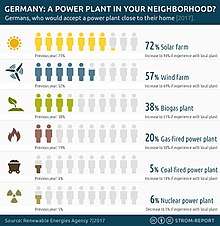
According to a 2017 national survey conducted for the German Renewable Energies Agency, of 1016 respondents 95% supported further expanding renewable energy.[67] Almost two-thirds of the interviewees agreed to renewable power plants close to their homes, with the support increasing further if respondents already had experience with such plants in their neighborhood. With solar farms it increased from 72 to 94%, with wind power from 57 to 69%, and with biofuels from 39 to 56%.
See also
- 100% renewable energy
- Amory Lovins
- Energy in Germany
- Energy policy of the European Union
- Geothermal power in Germany
- Germany National Renewable Energy Action Plan
- German Solar Industry Association
- Hermann Scheer
- List of countries by renewable electricity production
- Passivhaus
- Renewable energy commercialization
- Renewable energy in the European Union
- Renewable energy by country
- Solar power in Germany
- The Fourth Revolution: Energy
- Wind power in Germany
- Wildpoldsried
References
- https://windeurope.org/wp-content/uploads/files/about-wind/statistics/WindEurope-Annual-Statistics-2018.pdf
- Germany: The World's First Major Renewable Energy Economy
- Fraunhofer ISE, Electricity production from solar and wind in Germany – New record in wind power production, p.2 15 December 2014
- Burger, Bruno (15 January 2020). Public Net Electricity Generation in Germany 2019 (pdf). ise.fraunhofer.de. Freiburg, Germany: Fraunhofer Institute for Solar Energy Systems ISE. Retrieved 2 February 2020.
- Gerhardt, Christina (9 June 2016). "Germany's Renewable Energy Shift: Addressing Climate Change". Capitalism, Nature, Socialism. 28 (2): 103–119. doi:10.1080/10455752.2016.1229803.
- Renewable Energy Sources in Figures – National and International Development Archived 2 March 2012 at the Wayback Machine
- Germany Leads Way on Renewables, Sets 45% Target by 2030
- "100% renewable electricity supply by 2050". Federal Ministry for Environment, Nature Conservation and Nuclear Safety. 26 January 2011. Archived from the original on 9 May 2011. Retrieved 4 June 2011.
- Schultz, Stefan (23 March 2011). "Will Nuke Phase-Out Make Offshore Farms Attractive?". Der Spiegel. Retrieved 26 March 2011.
- The Wall Street Journal Online, 24 April 2012
- Burger, Bruno (15 January 2020). Public Net Electricity Generation in Germany 2019 (pdf). ise.fraunhofer.de. Freiburg, Germany: Fraunhofer Institute for Solar Energy Systems ISE. Retrieved 2 February 2020.
- Share in electricity supply has gone up to 14 per cent
- Federal Ministry of Economics and Technology (BMWi); Federal Ministry for the Environment, Nature Conservation and Nuclear Safety (BMU) (28 September 2010). Energy concept for an environmentally sound, reliable and affordable energy supply (PDF). Berlin, Germany: Federal Ministry of Economics and Technology (BMWi). Archived from the original (PDF) on 6 October 2016. Retrieved 16 June 2016.
- "Overview CDU/CSU and SPD Present Coalition Agreement – 55% to 60% Renewables by 2035 and More". German Energy Blog. Germany. 27 November 2013. Retrieved 16 June 2016.
- Fifth ″Energy Transition″ Monitoring Report: The Energy of the Future: 2015 Reporting Year – Summary (PDF). Berlin, Germany: Federal Ministry for Economic Affairs and Energy (BMWi). December 2016. Retrieved 15 February 2017.
- "Development of Renewable Energy Sources in 2011" (PDF). December 2012.
- "Bruttostromerzeugung in Deutschland von 1990 bis 2012 nach Energieträgern" (PDF). AG Energiebilanzen e.V. February 2013. Retrieved 10 June 2013.
- Burger, Bruno (8 May 2018). Power generation in Germany – assessment of 2017 (pdf). ise.fraunhofer.de. Freiburg, Germany: Fraunhofer Institute for Solar Energy Systems ISE. Retrieved 9 August 2018.
- "Germany heads for "spectacular" 2020 climate target miss – study". 7 September 2017.
- "Germany set to abandon 2020 climate target: Reports". 8 January 2018.
- Sandbag. "German electricity exports are fueling domestic coal mining – EUbusiness.com | EU news, business and politics". www.eubusiness.com. Retrieved 15 June 2018.
- "Solar- und Windenergieanlagen erzeugen im ersten Halbjahr 2019 mehr Strom als Kohlekraftwerke – Fraunhofer ISE". Fraunhofer-Institut für Solare Energiesysteme ISE (in German). Retrieved 25 July 2019.
- "Renewable energy providing more electricity than coal and nuclear power combined for first time in Germany". The Independent. 23 July 2019. Retrieved 25 July 2019.
- William Wilkes and Rachel Morison (21 April 2020). "Germany, With Skies Cleared by Coronavirus Lockdown, Produces Record Solar Power". Time.
Incidents of negative prices are increasing, with 773 negative prices recorded for 15-minute contracts in the first three months of the year, a 78% increase from the same period a year ago
- "Zeitreihen zur Entwicklung der erneuerbaren Energien in Deutschland" [Historic data about the development of renewable energies in Germany]. Erneuerbare Energien (in German). February 2018. Retrieved 9 August 2018.
- "Studie: Stromgestehungskosten erneuerbare Energien – März 2018". Fraunhofer ISE. 2018. Retrieved 2 April 2018.
- Germany: experience renewable energy — Baedeker Reiseführer. Germany: Baedeker. 2016. ISBN 978-382971499-0. Retrieved 14 June 2016.
- "GWEC Global Wind Statistics 2014" (PDF). GWEC. 10 February 2015. p. 3.
- Renewables 2014 Global Status Report, page 57
- Bundesministerium für Wirtschaft und Technologie (February 2012). "Die Energiewende in Deutschland" (PDF). Berlin. p. 4.
- Wind in power 2011 European statistics EWEA February 2012, pages 4 and 11
- Wind in power 2010 European statistics EWEA February 2011, page 11
- "Wind energy in Germany". Archived from the original on 24 March 2011.
- "72,6 Gigawatts Worldwide" (PDF). Wind Energy Barometer. February 2007. Retrieved 4 July 2007.
- "Germany Confirms End to Renewable Energy Feed-in Tariffs". 12 July 2016.
- http://energytransition.de/2012/09/e-biomass/
- German Biomass Strategy
- General Information – Biomass
- Bundesministeriums der Justiz in Zusammenarbeites mit der juris. 9 August 2009. Verordnung über Anforderungen an eine nachhaltige Herstellung von Biokraftstoffen (Biokraftstoff-Nachhaltigkeitsverordnung – Biokraft-NachV).
- BioenergyWiki: Policy implementation in Germany
- "Photovoltaikanlagen: Datenmeldungen sowie EEG-Vergütungssätze" [Monthly reported new installations of PV systems and current feed-in tariffs] (in German). Bundesnetzagentur. Retrieved 1 February 2015.
- Solar Power for the World: What You Wanted to Know about PhotovoltaicsTaylor & Francis Group
- Entwicklung des deutschen PV-Marktes Jan–Jul 2012 (German)
- Erneuerbare Energien liefern mehr als ein Viertel des Stroms
- Germany sets new solar power record, institute says
- "Global Market Outlook for Photovoltaics 2013 – 2017". European Photovoltaic Industry Association. Retrieved 19 March 2014.
- Another Sunny Year for Solar Power
- BSW-Solar, Statistische Zahlen der deutschen Solarstrombranche (Photovoltaik), Oct 2011
- General information – Hydropower
- Green energy boom in Germany
- Renewables 2014 Global Status Report, page 49
- "Nuclear sunset?". The Irish Times. 23 September 2011.
- Renewable Energy Sources in Germany – key information 2009 at a glance
- "Eye-watering cost of renewable revolution". World Nuclear News. 23 January 2012. Retrieved 26 January 2012.
- German Energy Blog Federal Cabinet Adopts 3.5 Billion Energy Research Programme
- German Energy Blog Clear Bundestag Majority for 2022 Nuclear Phase-Out and Coalition Party Approval for Energy Package
- German Energy Blog Overview Renewable Energy Sources Act
- EU2007.de – Historical agreement on climate protection
- EU2007.de – Historical agreement on climate protection
- "Germany's energy transformation Energiewende". The Economist. 28 July 2012. Retrieved 6 March 2013.
- "Germany's Energiewende is to maintain a balance between sustainability, affordability and competitiveness". International Energy Agency. 24 May 2013.
- "German law limits renewable growth – World Nuclear News".
- Renewables 2014 Global Status Report, page 27
- Includes all sorts of biomass, biofuels and biogas, e.g. methane from sewage and landfills, except the electricity generated from waste incineration of biomass. (See separate column "Bio waste incineration)."
- Bionic share of energy generation from waste incineration
- "A powerplant in your neighborhood?". Strom-Report.
- "Acceptance of power plants (German)". Retrieved 25 August 2017.
External links
External links
| Wikimedia Commons has media related to Renewable energy in Germany. |
- 2011 Renewable Energy Sources in Figures from the Federal Ministry for the Environment, Nature Conservation and Nuclear Safety – Renewable Energy
- For German Homeowners, Renewable Energy is No Longer a Choice
- Climate, Energy, and Environment Overview from the German Department of State
- Official site about renewable Energy in the Emscher-Lippe-Region
